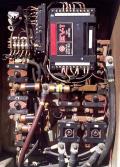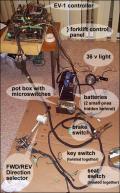Precharge resistor

| < prev. photo | next photo > |
Most controllers have banks of capacitors inside that help to smooth current flow. The capacitors gradually discharge when the controller is shut off, and recharge when it's switched back on.
To protect them from potentially life-shortening high amperage current in-rush when the controller is switched on, a precharge resistor is used to slow the flow of juice to a more capacitor-friendly rate.
In the ForkenSwift, the resistor we're using is one of the forklift's spotlight bulbs.
To protect them from potentially life-shortening high amperage current in-rush when the controller is switched on, a precharge resistor is used to slow the flow of juice to a more capacitor-friendly rate.
In the ForkenSwift, the resistor we're using is one of the forklift's spotlight bulbs.
View all ForkenSwift galleries > DC motor controller ...
 Curtis 1204-412 motor controller
Curtis 1204-412 motor controllerThat green box is the controller that's in the car now: a rebuilt Curtis 36-48 volt 400 amp DC motor controller original... |
 GE EV-1 control panel
GE EV-1 control panelHere's the brains of the forklift. This control panel includes all the circuitry, fuses and contactors (big relays)... |
 GE EV-1 DC motor controller
GE EV-1 DC motor controllerThe EV-1 SCR (silicon controlled resistance) type of controller actually has decent features: including adjustable accel... |
 The GE EV-1 controller on the "test bench"
The GE EV-1 controller on the "test bench"We knew that the EV-1 worked: we had dropped 3 marine batteries in the Baker forklift and moved it under its own power f... |
 GE EV-1 controller in action (light test)
GE EV-1 controller in action (light test)For testing, instead of controlling a DC motor, the EV-1 was hooked up to one of the 36 volt spotlights from the forklif... |
 Curtis 1204-410 36-48 volt 225 amp Club Car golf cart controller
Curtis 1204-410 36-48 volt 225 amp Club Car golf cart controllerEven after getting the EV-1 to work, we decided a "plug and play" golf cart controller would be easier for testing/devel... |
 Finned aluminum heat sink
Finned aluminum heat sink(Inset: controller mounted on the heatsink) Controllers can get pretty hot when they're worked hard or for a long tim... |
 Precharge resistor
Precharge resistorMost controllers have banks of capacitors inside that help to smooth current flow. The capacitors gradually discharge w... |
 Curtis 1204-412: adjustable features
Curtis 1204-412: adjustable featuresNote the adjustable current limiting (CL) and acceleration rate (ACC). Plug braking (PLUG) mode isn't used. For maxi... |